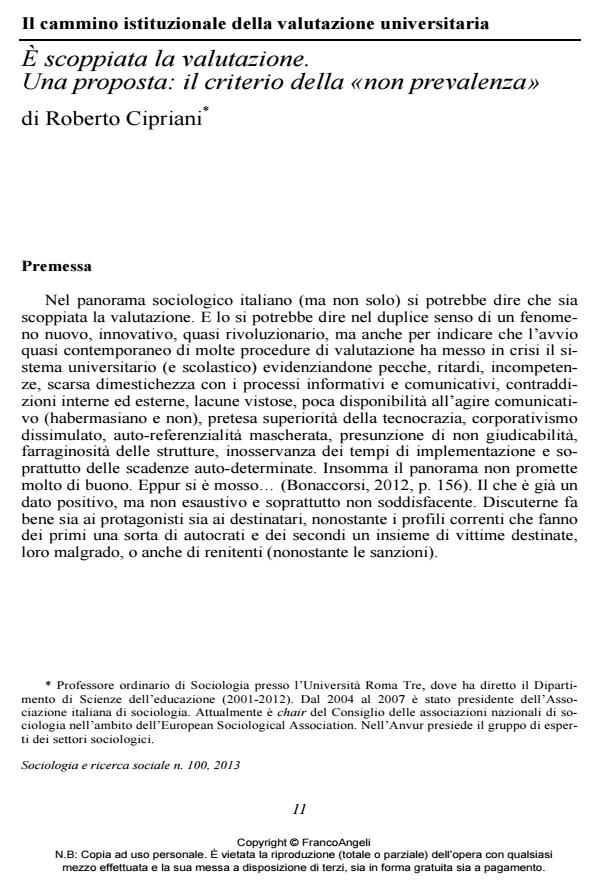The Evaluation Explosion. A Proposal: the Criteria of "Non Prevalence"
Journal title SOCIOLOGIA E RICERCA SOCIALE
Author/s Roberto Cipriani
Publishing Year 2013 Issue 2013/100
Language Italian Pages 6 P. 11-16 File size 584 KB
DOI 10.3280/SR2013-100002
DOI is like a bar code for intellectual property: to have more infomation
click here
Below, you can see the article first page
If you want to buy this article in PDF format, you can do it, following the instructions to buy download credits

FrancoAngeli is member of Publishers International Linking Association, Inc (PILA), a not-for-profit association which run the CrossRef service enabling links to and from online scholarly content.
We could say that an explosion of evaluation has taken place in the sociological panorama (and not only). This has a double meaning: in the sense of a new, innovative, almost revolutionary, phenomenon, but also to indicate that the almost contemporary activation and processing of evaluation has put the university (and school) system in crisis, highlighting faults, delays, incompetence, little familiarity with technology and communication practices, internal and external contradictions, evident flaws, unavailability to communicative action («habermasian » and not), the ascendance of technocracy, dissimulated corporativism, masked self-reference, presumption of no judgments, muddled structures, lack of observance of implementation times, and especially self-determined deadlines. The panorama is bleak, but something has been changing. It is advisable to avoid the tendency to use only qualitative or quantitative data. It is most important to always keep present the criteria of «non prevalence», meaning giving attention to every possible type of information, indicators or factors, which accompany and characterize the context and content of a study. The risk is otherwise that a scarcely relevant detail can become the only (or almost only) referential parameter, without the considering its significance in the context.
- AA. VV. (2012), «La valutazione della ricerca», Pedagogia oggi, 2, pp. 5-163.
- A. Baccini (2010), Valutare la ricerca. Uso e abuso degli strumenti bibliometrici, Bologna, il Mulino.
- L. Benadusi (2012), «La valutazione della ricerca e i rischi degli effetti perversi», Scuola democratica, 5, pp. 146-50.
- A. Bonaccorsi (2012), «La valutazione della ricerca come esperimento sociale», Scuola democratica, 6, pp. 156-65.
- E. Campelli (1999), Da un luogo comune. Elementi di metodologia delle scienze sociali, Roma, Carocci.
- J. Fitzpatrick, J. Sanders, B. Worthen (2004), Program Evaluation, Boston, Allyn & Bacon. Joint Committee on Standards for Educational Evaluation (2003), The Student Evaluation Standards, Thousand Oaks, Corwin Sage.
- W. Kula (1987), Le misure e gli uomini dall’antichità a oggi, Roma-Bari, Laterza.
- A.N. Langville, C.D. Meyer (2012), Who is number one? The Science of Rating and Ranking, Princeton, Princeton University Press.
- P. Miccoli, A. Fabris (a c. di) (2011), Valutare la ricerca? Capire, applicare, difendersi, Pisa, Ets.
- M. Palumbo (2001), Il processo di valutazione. Decidere, programmare, valutare, Milano, FrancoAngeli.
- P. Parra Saiani (2007), Considerazioni metodologiche (e non) sulla valutazione dell’università, in A. Baldissera, C. Coggi, R. Grimaldi (a c. di), Metodi di ricerca per la valutazione della didattica universitaria, Lecce, Pensa Multimedia.
- R. Stake (ed.) (1967), Curriculum Evaluation, Chicago, Rand McNally.
- R. Stake (2004), Standards-Based and Responsive Evaluation, Thousand Oaks, Sage.
Roberto Cipriani, È scoppiata la valutazione. Una proposta: il criterio della «non prevalenza» in "SOCIOLOGIA E RICERCA SOCIALE " 100/2013, pp 11-16, DOI: 10.3280/SR2013-100002